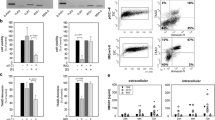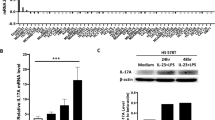Abstract
Polyinosinic-polycytidylic acid [Poly (I: C)], a ligand for Toll-like receptor (TLR-3), is used as an adjuvant to enhance anti-tumor immunity because of its prominent effects on CD8 T cells and NK cells. Myeloid-derived suppressor cells (MDSCs) are one of the main immunosuppressive factors in cancer, and their abnormal accumulation is correlated with the clinical stage of breast cancer and is an important mechanism of tumor immune evasion. Although Poly (I: C) is thought to have direct anti-tumor activity in different cell lines, its effect on immunosuppressive MDSCs in tumor-bearing animals has not been studied. 4T1-Luc, a metastatic breast cancer mouse cell line, was injected into the left flank of female BALB/c mice. Tumor-bearing mice were treated with i.p. injection of Poly (I: C) or PBS beginning on day 7 after tumor inoculation. WBCs and MDSCs were counted using coulter counter and stained for flow cytometry, respectively. Bioluminescent imaging was used to monitor tumor burden at multiple time points during the course of tumor growth. Poly (I: C) treatment led to a decrease in MDSC frequencies in BM, blood, and tumor compared to saline-treated control mice. Poly (I: C) treatment also abrogated the immunosuppressive function of MDSCs, concomitant with an increase in local T cell response of the immune system in a murine model of breast cancer. Poly (I: C) treatment decreases MDSC frequency and immunosuppressive function in 4T1-tumor-bearing hosts and effectively augments the activity of breast cancer immunotherapy.





Similar content being viewed by others
Abbreviations
- MDSC:
-
Myeloid-derived suppressor cells
- S.C:
-
Subcutaneous
- I.P:
-
Intra peritoneal
- BLI:
-
Bioluminescence intensity
- ROI:
-
Regions of interest
- Luc:
-
Luciferase
- Lin:
-
Lineage
- FACS:
-
Fluorescent activated cell sorting
- IMC:
-
Immature myeloid cell
References
Zoglmeier C, Bauer H, Norenberg D, Wedekind G, Bittner P, Sandholzer N, Rapp M, Anz D, Endres S, Bourquin C (2011) CpG blocks immunosuppression by myeloid-derived suppressor cells in tumor-bearing mice. Clin Cancer Res 17(7):1765–1775
Finke J (2011) MDSC as a mechanism of tumor escape from sunitinib mediated anti-angiogenic. Inter Immunopharmacol 11:856
Nakamura H, Horai Y, Suzuki T, Okada A, Ichinose K, Yamasaki S, Koji T, Kawakami A (2013) TLR3-mediated apoptosis and activation of phosphorylated Akt in the salivary gland epithelial cells of primary Sjogren’s syndrome patients. Rheumatol Int 33(2):441–450
Markowitz J, Wesolowski R, Papenfuss T, Brooks TR, Carson WE 3rd (2013) Myeloid-derived suppressor cells in breast cancer. Breast Cancer Res Treat 140(1):13–21
Harashima N, Inao T, Imamura R, Okano S, Suda T, Harada M (2012) Roles of the PI3 K/Akt pathway and autophagy in TLR3 signaling-induced apoptosis and growth arrest of human prostate cancer cells. Cancer Immunol Immunother 61(5):667–676
Sun R, Zhang Y, Lv Q, Liu B, Jin M, Zhang W, He Q, Deng M, Liu X, Li G et al (2011) Toll-like receptor 3 (TLR3) induces apoptosis via death receptors and mitochondria by up-regulating the transactivating p63 isoform alpha (TAP63alpha). J Biol Chem 286(18):15918–15928
Taura M, Fukuda R, Suico MA, Eguma A, Koga T, Shuto T, Sato T, Morino-Koga S, Kai H (2010) TLR3 induction by anticancer drugs potentiates poly I:C-induced tumor cell apoptosis. Cancer Sci 101(7):1610–1617
Liechtenstein T, Perez-Janices N, Gato M, Caliendo F, Kochan G, Blanco-Luquin I, Van der Jeught K, Arce F, Guerrero-Setas D, Fernandez-Irigoyen J et al (2014) A highly efficient tumor-infiltrating MDSC differentiation system for discovery of anti-neoplastic targets, which circumvents the need for tumor establishment in mice. Oncotarget 5(17):7843–7857
Ghansah T (2012) A novel strategy for modulation of MDSC to enhance cancer immunotherapy. Oncoimmunology 1(6):984–985
Mignot G, Chalmin F, Ladoire S, Rébé C, Ghiringhelli F (2011) Tumor exosome-mediated MDSC activation. Am J pathol 178(3):1403–1405
Green TL, Santos MF, Ejaeidi AA, Craft BS, Lewis RE, Cruse JM (2014) Toll-like receptor (TLR) expression of immune system cells from metastatic breast cancer patients with circulating tumor cells. Exp Mol Pathol 97(1):44–48
Diaz-Montero CM, Salem ML, Nishimura MI, Garrett-Mayer E, Cole DJ, Montero AJ (2009) Increased circulating myeloid-derived suppressor cells correlate with clinical cancer stage, metastatic tumor burden, and doxorubicin-cyclophosphamide chemotherapy. Cancer Immunol Immunother 58(1):49–59
Chi N, Tan Z, Ma K, Bao L, Yun Z (2014) Increased circulating myeloid-derived suppressor cells correlate with cancer stages, interleukin-8 and -6 in prostate cancer. Int J Clin Exp Med 7(10):3181–3192
Salaun B, Coste I, Rissoan MC, Lebecque SJ, Renno T (2006) TLR3 can directly trigger apoptosis in human cancer cells. J Immunol 176(8):4894–4901
Cheng YS, Xu F (2010) Anticancer function of polyinosinic-polycytidylic acid. Cancer Biol Ther 10(12):1219–1223
Forghani P, Khorramizadeh MR, Waller EK (2014) Silibinin inhibits accumulation of myeloid-derived suppressor cells and tumor growth of murine breast cancer. Cancer Med 3(2):215–224
Ray A, Dittel BN (2010) Isolation of mouse peritoneal cavity cells. J Vis Exp 35:1488
Forghani P, Harris W, Giver CR, Mirshafiey A, Galipeau J, Waller EK (2013) Properties of immature myeloid progenitors with nitric-oxide-dependent immunosuppressive activity isolated from bone marrow of tumor-free mice. PLoS ONE 8(7):e64837
Ostrand-Rosenberg S, Sinha P, Chornoguz O, Ecker C (2012) Regulating the suppressors: apoptosis and inflammation govern the survival of tumor-induced myeloid-derived suppressor cells (MDSC). Cancer Immunol Immunother 61(8):1319–1325
Sinha P, Okoro C, Foell D, Freeze HH, Ostrand-Rosenberg S, Srikrishna G (2008) Proinflammatory S100 proteins regulate the accumulation of myeloid-derived suppressor cells. J Immunol 181(7):4666–4675
Fucikova J, Rozkova D, Ulcova H, Budinsky V, Sochorova K, Pokorna K, Bartunkova J, Spisek R (2011) Poly I: C-activated dendritic cells that were generated in Cell Gro for use in cancer immunotherapy trials. J Trans Med 9:223
Verdijk RM, Mutis T, Esendam B, Kamp J, Melief CJ, Brand A, Goulmy E (1999) Polyriboinosinic polyribocytidylic acid (poly(I:C)) induces stable maturation of functionally active human dendritic cells. J Immunol 163(1):57–61
Moller I, Michel K, Frech N, Burger M, Pfeifer D, Frommolt P, Veelken H, Thomas-Kaskel AK (2008) Dendritic cell maturation with poly(I:C)-based versus PGE2-based cytokine combinations results in differential functional characteristics relevant to clinical application. J Immunother 31(5):506–519
Nagaraj S, Nelson A, Youn JI, Cheng P, Quiceno D, Gabrilovich DI (2012) Antigen-specific CD4(+) T cells regulate function of myeloid-derived suppressor cells in cancer via retrograde MHC class II signaling. Cancer Res 72(4):928–938
Kulbe H, Thompson R, Wilson JL, Robinson S, Hagemann T, Fatah R, Gould D, Ayhan A, Balkwill F (2007) The inflammatory cytokine tumor necrosis factor-alpha generates an autocrine tumor-promoting network in epithelial ovarian cancer cells. Cancer Res 67(2):585–592
Charles KA, Kulbe H, Soper R, Escorcio-Correia M, Lawrence T, Schultheis A, Chakravarty P, Thompson RG, Kollias G, Smyth JF et al (2009) The tumor-promoting actions of TNF-alpha involve TNFR1 and IL-17 in ovarian cancer in mice and humans. J Clin Invest 119(10):3011–3023
Salaun B, Zitvogel L, Asselin-Paturel C, Morel Y, Chemin K, Dubois C, Massacrier C, Conforti R, Chenard MP, Sabourin JC et al (2011) TLR3 as a biomarker for the therapeutic efficacy of double-stranded RNA in breast cancer. Cancer Res 71(5):1607–1614
Bunt SK, Clements VK, Hanson EM, Sinha P, Ostrand-Rosenberg S (2009) Inflammation enhances myeloid-derived suppressor cell cross-talk by signaling through Toll-like receptor 4. J Leukoc Biol 85(6):996–1004
Conrad E, Resch TK, Gogesch P, Kalinke U, Bechmann I, Bogdan C, Waibler Z (2014) Protection against RNA-induced liver damage by myeloid cells requires type I interferon and IL-1 receptor antagonist in mice. Hepatology 59(4):1555–1563
Aranda F, Llopiz D, Diaz-Valdes N, Riezu-Boj JI, Bezunartea J, Ruiz M, Martinez M, Durantez M, Mansilla C, Prieto J et al (2011) Adjuvant combination and antigen targeting as a strategy to induce polyfunctional and high-avidity T-cell responses against poorly immunogenic tumors. Cancer Res 71(9):3214–3224
Paone A, Starace D, Galli R, Padula F, De Cesaris P, Filippini A, Ziparo E, Riccioli A (2008) Toll-like receptor 3 triggers apoptosis of human prostate cancer cells through a PKC-alpha-dependent mechanism. Carcinogenesis 29(7):1334–1342
Forte G, Rega A, Morello S, Luciano A, Arra C, Pinto A, Sorrentino R (2012) Polyinosinic-polycytidylic acid limits tumor outgrowth in a mouse model of metastatic lung cancer. J Immunol 188(11):5357–5364
Shime H, Kojima A, Maruyama A, Saito Y, Oshiumi H, Matsumoto M, Seya T (2014) Myeloid-derived suppressor cells confer tumor-suppressive functions on natural killer cells via polyinosinic:polycytidylic acid treatment in mouse tumor models. J Innate Immun 6(3):293–305
Ostrand-Rosenberg S, Sinha P, Beury DW, Clements VK (2012) Cross-talk between myeloid-derived suppressor cells (MDSC), macrophages, and dendritic cells enhances tumor-induced immune suppression. Semin Cancer Biol 22(4):275–281
Dalotto-Moreno T, Croci DO, Cerliani JP, Martinez-Allo VC, Dergan-Dylon S, Mendez-Huergo SP, Stupirski JC, Mazal D, Osinaga E, Toscano MA et al (2013) Targeting galectin-1 overcomes breast cancer-associated immunosuppression and prevents metastatic disease. Cancer Res 73(3):1107–1117
Kovacs-Solyom F, Blasko A, Fajka-Boja R, Katona RL, Vegh L, Novak J, Szebeni GJ, Krenacs L, Uher F, Tubak V et al (2010) Mechanism of tumor cell-induced T-cell apoptosis mediated by galectin-1. Immunol Lett 127(2):108–118
Liu C, Zhang C, Lu H, Cai J, Wang Z, Chen J, Liu F, Wu Z, Liu X, Sun W (2011) Poly(I:C) induce bone marrow precursor cells into myeloid-derived suppressor cells. Mol Cell Biochem 358(1–2):317–323
Danilin S, Merkel AR, Johnson JR, Johnson RW, Edwards JR, Sterling JA (2012) Myeloid-derived suppressor cells expand during breast cancer progression and promote tumor-induced bone destruction. Oncoimmunology 1(9):1484–1494
Acknowledgments
The authors thank Dr. Ragavan Chinnadurai for his guidance; Wayne Harris for his helpful technical assistance in sorting and Christopher Peterson for help in Western blotting. Also author thanks Anthea Hamond for her careful reading and editing of manuscript.
Author information
Authors and Affiliations
Corresponding author
Ethics declarations
Conflict of interest
The authors disclose no potential conflicts of interest.
Electronic supplementary material
Below is the link to the electronic supplementary material.
10549_2015_3508_MOESM1_ESM.tif
Figure. S1. Poly (I: C) treatment decreases the frequency and absolute numbers of MDSCs 4T1 tumor cells were implanted into the 1st left mammary fat pad of female BALB/c mice (1 × 106 cells per mouse, n = 4 per group). Blood samples were obtained on week three after tumor inoculation. (A) Flow cytometry analysis of blood showing mean percentages of MDSCs and CD3+ T cells in Poly (I: C)-treated and PBS-treated tumor-bearing mice vs. non-tumor bearing Poly (I: C)-treated mice. Mean frequencies (±SD) from three separate experiments. (B) Absolute numbers of MDSCs and CD3+ T cells in the blood after tumor inoculation in two groups. Two-way ANOVA* shows statistically significant differences from control (p < 0.05) from three independent experiments.
Rights and permissions
About this article
Cite this article
Forghani, P., Waller, E.K. Poly (I: C) modulates the immunosuppressive activity of myeloid-derived suppressor cells in a murine model of breast cancer. Breast Cancer Res Treat 153, 21–30 (2015). https://doi.org/10.1007/s10549-015-3508-y
Received:
Accepted:
Published:
Issue Date:
DOI: https://doi.org/10.1007/s10549-015-3508-y




